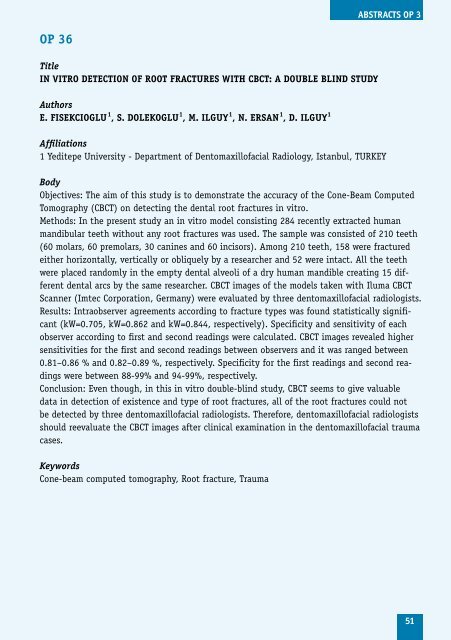Program including abstracts as pdf available here
Program including abstracts as pdf available here
Program including abstracts as pdf available here
You also want an ePaper? Increase the reach of your titles
YUMPU automatically turns print PDFs into web optimized ePapers that Google loves.
OP 36<br />
Title<br />
IN VITRO DETECTION OF ROOT FRACTuRES WITH CbCT: A DOubLE bLIND STuDy<br />
Authors<br />
E. FISEKCIOGLu 1 , S. DOLEKOGLu 1 , M. ILGuy 1 , N. ERSAN 1 , D. ILGuy 1<br />
Affiliations<br />
1 Yeditepe University - Department of Dentomaxillofacial Radiology, Istanbul, TURKEY<br />
Body<br />
Objectives: The aim of this study is to demonstrate the accuracy of the Cone-Beam Computed<br />
Tomography (CBCT) on detecting the dental root fractures in vitro.<br />
Methods: In the present study an in vitro model consisting 284 recently extracted human<br />
mandibular teeth without any root fractures w<strong>as</strong> used. The sample w<strong>as</strong> consisted of 210 teeth<br />
(60 molars, 60 premolars, 30 canines and 60 incisors). Among 210 teeth, 158 were fractured<br />
either horizontally, vertically or obliquely by a researcher and 52 were intact. All the teeth<br />
were placed randomly in the empty dental alveoli of a dry human mandible creating 15 different<br />
dental arcs by the same researcher. CBCT images of the models taken with Iluma CBCT<br />
Scanner (Imtec Corporation, Germany) were evaluated by three dentomaxillofacial radiologists.<br />
Results: Intraobserver agreements according to fracture types w<strong>as</strong> found statistically significant<br />
(kW=0.705, kW=0.862 and kW=0.844, respectively). Specificity and sensitivity of each<br />
observer according to first and second readings were calculated. CBCT images revealed higher<br />
sensitivities for the first and second readings between observers and it w<strong>as</strong> ranged between<br />
0.81–0.86 % and 0.82–0.89 %, respectively. Specificity for the first readings and second readings<br />
were between 88-99% and 94-99%, respectively.<br />
Conclusion: Even though, in this in vitro double-blind study, CBCT seems to give valuable<br />
data in detection of existence and type of root fractures, all of the root fractures could not<br />
be detected by three dentomaxillofacial radiologists. T<strong>here</strong>fore, dentomaxillofacial radiologists<br />
should reevaluate the CBCT images after clinical examination in the dentomaxillofacial trauma<br />
c<strong>as</strong>es.<br />
Keywords<br />
Cone-beam computed tomography, Root fracture, Trauma<br />
aBSTracTS OP 3<br />
51


